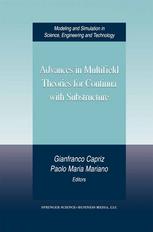

Most ebook files are in PDF format, so you can easily read them using various software such as Foxit Reader or directly on the Google Chrome browser.
Some ebook files are released by publishers in other formats such as .awz, .mobi, .epub, .fb2, etc. You may need to install specific software to read these formats on mobile/PC, such as Calibre.
Please read the tutorial at this link: https://ebookbell.com/faq
We offer FREE conversion to the popular formats you request; however, this may take some time. Therefore, right after payment, please email us, and we will try to provide the service as quickly as possible.
For some exceptional file formats or broken links (if any), please refrain from opening any disputes. Instead, email us first, and we will try to assist within a maximum of 6 hours.
EbookBell Team

5.0
50 reviewsThe current use of complex materials in nanotechnology and industrial engineering has led to a number of intricate problems in mechanics. The macroscopic behavior of such materials often depends critically on their substructures. Multifield theories in continuum mechanics provide the tools for modeling and describing these material substructures, as is emphasized in this book. Indeed multifield theories are an active area of research because of the numerous theoretical and numerical problems emerging in the field.
Written by leading mathematicians and engineers, the chapters feature a broad range of topics that offer both experimental results and clear, detailed answers to fundamental questions about the general formulation of multifield theories. Amid a rich collection of open problems, selected subjects treated include:
* Energetic and geometric properties of elastic-plastic materials
* Poisson structures for complex fluids
* Drag reduction in turbulence due to polymeric substructures
* Topological properties of stresses and defects
* Exact relations for the effective behavior of composites
* Multifield macroscopic modeling of shape memory effects and extended thermodynamics
* Properties of junctions and interfaces
Applied mathematicians, mechanical and structural engineers, material scientists, graduate students, and researchers in the above areas will benefit from this work.
Contributors:
D. Bernardini, G. Capriz, C. M. Casciola, H. Cendra, E. DeAngelis, Y. Grabovsky, P. M. Mariano, J. Marsden, I. Müller, O. B. Naimark, G. Parry, T. J. Pence, R. Piva, T. S. Ratiu, R. Segev, M. Silhavy